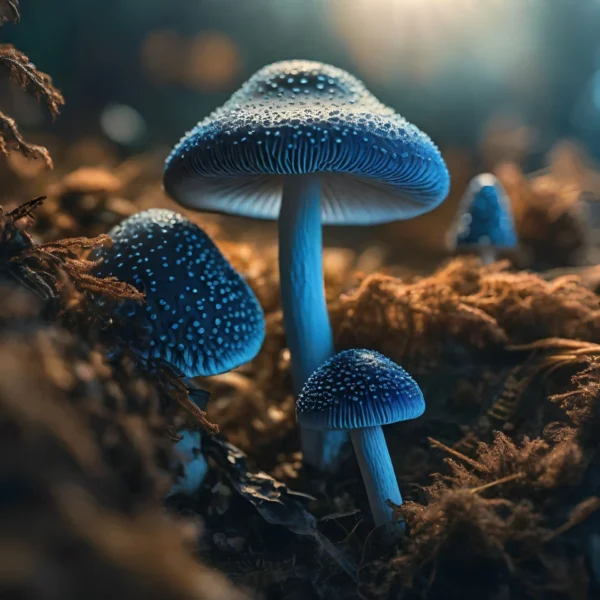Magic mushrooms, or Psilocybe fungi, have captivated the scientific community and popular culture with their psychotropic prowess and a particularly peculiar property: they turn a deep, mystical blue when cut or bruised. This enigmatic colour change has been a topic of fascination and debate for decades, drawing parallels to the indigo dyeing process that produces the classic blue of our jeans. Despite its well-documented existence, the biochemical pathway behind this transformation remained an unsolved riddle—until now. Thanks to the dedicated efforts of Dirk Hoffmeister‘s team at the Leibniz Institute for Natural Product Research and Infection Biology in Germany, the veil shrouding this colourful mystery has finally been lifted. As reported in Chemistry World (Mystery of Why Magic Mushrooms Go Blue Solved), this discovery sheds light on the complex chemistry of these enigmatic fungi. It paves the way for a deeper understanding of their potential uses in medicine.
The Mystery of the Blue Hue
The signature blue hue that emerges on magic mushrooms when damaged has intrigued both mycologists and mushroom aficionados alike. Unlike the Boletales family of mushrooms, where a specific substance called gyrocyanin is the known source of their blue coloration, Psilocybe’s azure transformation occurs without a clear, identifiable compound. Previous research had established that this blue colour was connected to the oxidation of psilocybin, the psychoactive component in these fungi. However, the specifics of the pigment responsible and the biochemical pathway that produced it remained elusive, leaving a gap in our understanding of these complex organisms.
For years, the scientific world could only speculate about this phenomenon, as efforts to extract and purify the blue compound were met with failure. This conundrum challenged researchers and led to the abandonment of the pursuit by many skilled investigators. The elusive nature of the blue pigment in Psilocybe mushrooms posed a tantalizing question that remained unanswered until the perseverance and innovative approach of Hoffmeister and his team set a new course to uncover the mystery. Their journey into the blue hinted at a reaction unlike any observed in nature before, one that would require digging deep into an analytical toolbox to unravel.
Breakthrough Research by Hoffmeister’s Team

The quest to understand the cause of the blue coloration in magic mushrooms took a significant turn with the work of Dirk Hoffmeister’s research team at the Leibniz Institute for Natural Product Research and Infection Biology. For several years, Hoffmeister’s group had been cultivating Psilocybe cubensis in their laboratory, witnessing the enigmatic blueing reaction firsthand on countless occasions. Driven by curiosity and a resolve to solve a phenomenon that had puzzled scientists for so long, Hoffmeister’s team decided to take a different approach in their research.
The team’s dedication soon became evident as they embarked on an unconventional journey, utilizing advanced analytical techniques that had not been applied to this mystery before. Instead of following traditional extraction and purification methods—which had consistently led to dead ends—the researchers employed a suite of sophisticated analytical tools to observe the reaction as it occurred.
Liquid chromatography–mass spectrometry (LC-MS), Maldi mass spectrometry, infrared spectroscopy, and time-resolved nuclear magnetic resonance (NMR) spectroscopy were all part of the analytical arsenal that Hoffmeister’s team leveraged to gain insights into the blue pigments. These powerful techniques allowed the researchers to catch a glimpse of the fleeting compounds as they formed, leading to groundbreaking discoveries about the complex chemistry underlying the blue coloration in magic mushrooms.
The determination of Hoffmeister’s team to employ these unconventional methods brought them closer to deciphering a biochemical puzzle that had stumped previous researchers for decades. Their innovative approach and tireless efforts would soon yield results that provided not just answers but also new questions about the nature of these captivating fungi.
Advanced Analytical Techniques
To delve into the molecular intricacies behind the blue coloration of magic mushrooms, Hoffmeister’s team turned to a selection of advanced analytical techniques that would allow them to observe the elusive compounds responsible for this reaction. The cornerstone of their investigative approach was a combination of liquid chromatography–mass spectrometry (LC-MS) and Maldi mass spectrometry. These techniques provided the sensitivity and specificity required to identify and characterize the molecular components that formed during the oxidation process of psilocybin.
Infrared spectroscopy offered additional insights by capturing the vibrational signatures of the chemical bonds within the compounds, further detailing their structures. However, it was time-resolved nuclear magnetic resonance (NMR) spectroscopy that proved pivotal in monitoring the reaction kinetics and understanding how these compounds evolved over time. NMR spectroscopy allowed the researchers to observe the transformation of psilocybin and its byproducts in real time, a crucial aspect of deciphering the sequential steps leading to the formation of the blue pigments.
By leveraging these sophisticated techniques, Hoffmeister’s team could visualize and track the cascade of chemical reactions as they unfolded, marking a significant advancement in mushroom chemistry. The use of these methods not only enabled the identification and analysis of the compounds involved but also painted a dynamic picture of the chemical dance that gives rise to the enigmatic blue hue of bruised Psilocybe mushrooms. This innovative approach was instrumental in demystifying the biochemical pathway that had remained hidden from scientists for so long.
The Blue Pigment Revealed
The meticulous application of advanced analytical techniques finally bore fruit, revealing that the blue pigment seen in magic mushrooms is not the work of a single compound, but rather a complex mixture arising from the oxidation of psilocybin. The critical discovery made by Hoffmeister’s team was identifying a series of compounds known as quinoid psilocyl oligomers. These compounds, sharing a structural similarity to indigo with their deep blue pigment, are formed as part of a cascade reaction that begins with psilocybin itself.
The first step in this cascade involves a phosphatase enzyme that removes a phosphate group from psilocybin, converting it to psilocin. Subsequently, an oxidizing agent, specifically a laccase enzyme, acts upon the psilocin, generating psilocyl radicals. These radicals then combine to form dimers with C-5 linkage and continue to polymerize through C-7 couplings, eventually giving rise to the characteristic blue compounds.
This intricate process results in various oligomers that contribute to the overall blue coloration observed when the mushrooms are damaged. The team was able to isolate and identify six different mushroom pigments, each a product of this fascinating biochemical chain reaction. This revelation provided a much clearer understanding of the molecular dance that led to the formation of the blue hue, a question that had puzzled scientists for so long.
Understanding the precise nature of these quinoid structures and their formation has not only solved a longstanding mystery but has also highlighted the complex and dynamic chemical processes occurring within these fungi. The discovery of this biochemical pathway showcases the sophisticated natural chemistry at play and opens the door for further exploration into the roles these pigments serve within the mushroom and their potential applications beyond.
Potential Functions of the Blue Pigments
While the chemical pathway to the blue pigments in magic mushrooms has been elucidated, the question of their function in the life of the fungi remains. Hoffmeister and his team have proposed a hypothesis that these pigments may serve a protective role for the mushrooms. They speculate that the blue compounds could act as an on-demand repellent or deterrent to predators, triggered by the physical damage to the mushroom’s tissues.
The pigments possibly contribute to a defence mechanism by producing reactive oxygen species when the mushroom is bruised or cut. These reactive species could be toxic to insects or other potential predators, discouraging them from feeding on the mushrooms. This kind of chemical defence strategy is not uncommon in the plant and fungal kingdoms, where substances that are harmful to predators are synthesized in response to injury or attack.
However, this hypothesis concerning the blue pigments’ purpose is yet to be supported by experimental evidence. Further research will be required to validate this theory and to fully understand the ecological significance of the blue coloration. The protective function of these pigments could be an important aspect of Psilocybe mushrooms’ survival strategy, and uncovering this facet of their biology could provide valuable insights into the evolutionary pressures that have shaped these organisms.
The research into these pigments is not just a matter of academic curiosity; it also has implications for our broader understanding of natural product chemistry and the roles that secondary metabolites play in the environment. As scientists continue to investigate, they may uncover new aspects of mushroom ecology and potentially find novel applications for these compounds.
Ecological and Medical Significance

The ecological role of the blue pigments in magic mushrooms is yet to be fully understood, but the implications of such a discovery extend beyond mere curiosity. Jaclyn Winter, an expert in natural product biosynthesis in bacteria and fungi at the University of Utah, points to the anticipation of future studies that may reveal the true ecological role these molecules play. There is a consensus in the scientific community that these pigments have evolved to serve a specific function for the mushroom, which could range from protection against environmental stressors to interactions with other organisms in their ecosystem.
Beyond their ecological importance, the medical significance of Psilocybe mushrooms has come into sharp focus. The active compound psilocybin, once regarded solely as an illegal recreational drug, is now being recognized for its potential as a medication for therapy-resistant depression. Research and clinical trials are underway to explore and validate the therapeutic benefits of psilocybin. Notably, with psilocybin being legalized for medical use in various states across the U.S., there has been a surge in interest from both scientific and medical communities.
The groundbreaking study by Hoffmeister’s team not only contributes to a deeper understanding of mushroom chemistry but also helps shift the perception of psilocybin within society. As more groups study psilocybin and its effects, both in terms of its natural production in fungi and its potential as a psychiatric treatment, we are likely to see a significant impact on the field.
Winter echoes this sentiment, highlighting the importance of these developments. The increased attention on psilocybin, facilitated by its legalization and ongoing trials, promises to unlock further secrets of its chemistry and utility. This could lead to new treatments for mental health conditions and change the trajectory of how we approach mental wellness therapies.
In summary, while the blue pigments of Psilocybe mushrooms present an intriguing ecological puzzle, the broader implications of this research touch upon vital issues of mental health and our relationship with natural psychotropic substances. The study by Hoffmeister’s team is more than a scientific inquiry—it is a step toward a future where natural products are better understood and appreciated for their full potential in science and medicine.
Conclusion
In conclusion, the discovery of the chemical processes behind the blue coloration of magic mushrooms marks a significant milestone in the field of mycology and natural product chemistry. The meticulous work by Dirk Hoffmeister’s team has not only solved a decades-old mystery but has also highlighted the intricate and sophisticated chemistry that nature employs. This newfound understanding may inspire further research into the chemistry of fungi and other natural organisms, potentially leading to novel applications.
Moreover, the implications of this research extend into the realms of ecology and medicine, where the true function of these pigments within their natural environment remains an open question for future exploration. In the medical context, this study contributes to the changing perception of psilocybin, from a substance of misuse to a compound of great therapeutic potential, particularly in the treatment of mental health disorders.
As we continue to unravel the complexities of natural compounds and their roles within living organisms, we also expand our capacity to harness these substances for the benefit of human health and well-being. The study into the blue pigments of Psilocybe mushrooms serves as a reminder of the vast and largely untapped potential that lies within the natural world—a potential that, when understood, can lead to profound advancements in both science and medicine.
